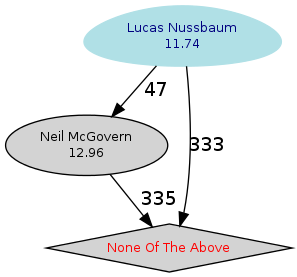Debian Project Leader Elections 2014
Time Line
| Nomination period: | Monday, March 3th 00:00:00 UTC, 2014 | Sunday, March 9th 23:59:59 UTC, 2014 |
|---|---|---|
| Campaigning period: | Monday, March 10th 00:00:00 UTC, 2014 | Sunday, March 30th 23:59:59 UTC, 2014 |
| Voting period: | Monday, March 31st, 00:00:00 UTC, 2014 | Sunday, April 13th, 23:59:59 UTC, 2014 |
Please note that the new term for the project leader shall start on April 17th, 2014.
Nominations
- Lucas Nussbaum [[email protected]] [nomination mail] [platform]
- Neil McGovern [[email protected]] [nomination mail] [platform]
Withdrawn nomination:
- Gergely Nagy [[email protected]] [nomination mail] [withdrawal mail]
The ballot, when ready, can be requested through email by sending a signed email to [email protected] with the subject leader2014.
Data and Statistics
This year, like always, statistics will be gathered about ballots received and acknowledgements sent periodically during the voting period. Additionally, the list of voters will be recorded. Also, the tally sheet will also be made available to be viewed. Please remember that the project leader election has a secret ballot, so the tally sheet will not contain the voter's name but a HMAC that allows the voters to check that their vote is in the list of votes. There is a key generated for each voter that is send along with the ack for the vote.
Quorum
With the current list of voting developers, we have:
Current Developer Count = 1003
Q ( sqrt(#devel) / 2 ) = 15.8350876221131
K min(5, Q ) = 5
Quorum (3 x Q ) = 47.5052628663394
Quorum
- Option1 Reached quorum: 364 > 47.5052628663394
- Option2 Reached quorum: 363 > 47.5052628663394
Majority Requirement
All candidates would need a simple majority to be eligible.
Majority
- Option1 passes Majority. 11.742 (364/31) >= 1
- Option2 passes Majority. 12.964 (363/28) >= 1
Outcome
In the graph above, any pink colored nodes imply that the option did not pass majority, the Blue is the winner. The Octagon is used for the options that did not beat the default.
- Option 1 "Lucas Nussbaum"
- Option 2 "Neil McGovern"
- Option 3 "None Of The Above"
In the following table, tally[row x][col y] represents the votes that option x received over option y. A more detailed explanation of the beat matrix may help in understanding the table. For understanding the Condorcet method, the Wikipedia entry is fairly informative.
| Option | |||
|---|---|---|---|
| 1 | 2 | 3 | |
| Option 1 | 205 | 364 | |
| Option 2 | 158 | 363 | |
| Option 3 | 31 | 28 | |
Looking at row 2, column 1, Neil McGovern
received 158 votes over Lucas Nussbaum
Looking at row 1, column 2, Lucas Nussbaum
received 205 votes over Neil McGovern.
Pair-wise defeats
- Option 1 defeats Option 2 by ( 205 - 158) = 47 votes.
- Option 1 defeats Option 3 by ( 364 - 31) = 333 votes.
- Option 2 defeats Option 3 by ( 363 - 28) = 335 votes.
The Schwartz Set contains
- Option 1 "Lucas Nussbaum"
The winners
- Option 1 "Lucas Nussbaum"
Debian uses the Condorcet method for voting.
Simplistically, plain Condorcets method
can be stated like so :
Consider all possible two-way races between candidates.
The Condorcet winner, if there is one, is the one
candidate who can beat each other candidate in a two-way
race with that candidate.
The problem is that in complex elections, there may well
be a circular relationship in which A beats B, B beats C,
and C beats A. Most of the variations on Condorcet use
various means of resolving the tie. See
Cloneproof Schwartz Sequential Dropping
for details. Debian's variation is spelled out in the
constitution,
specifically, A.6.
Debian Project Secretary

